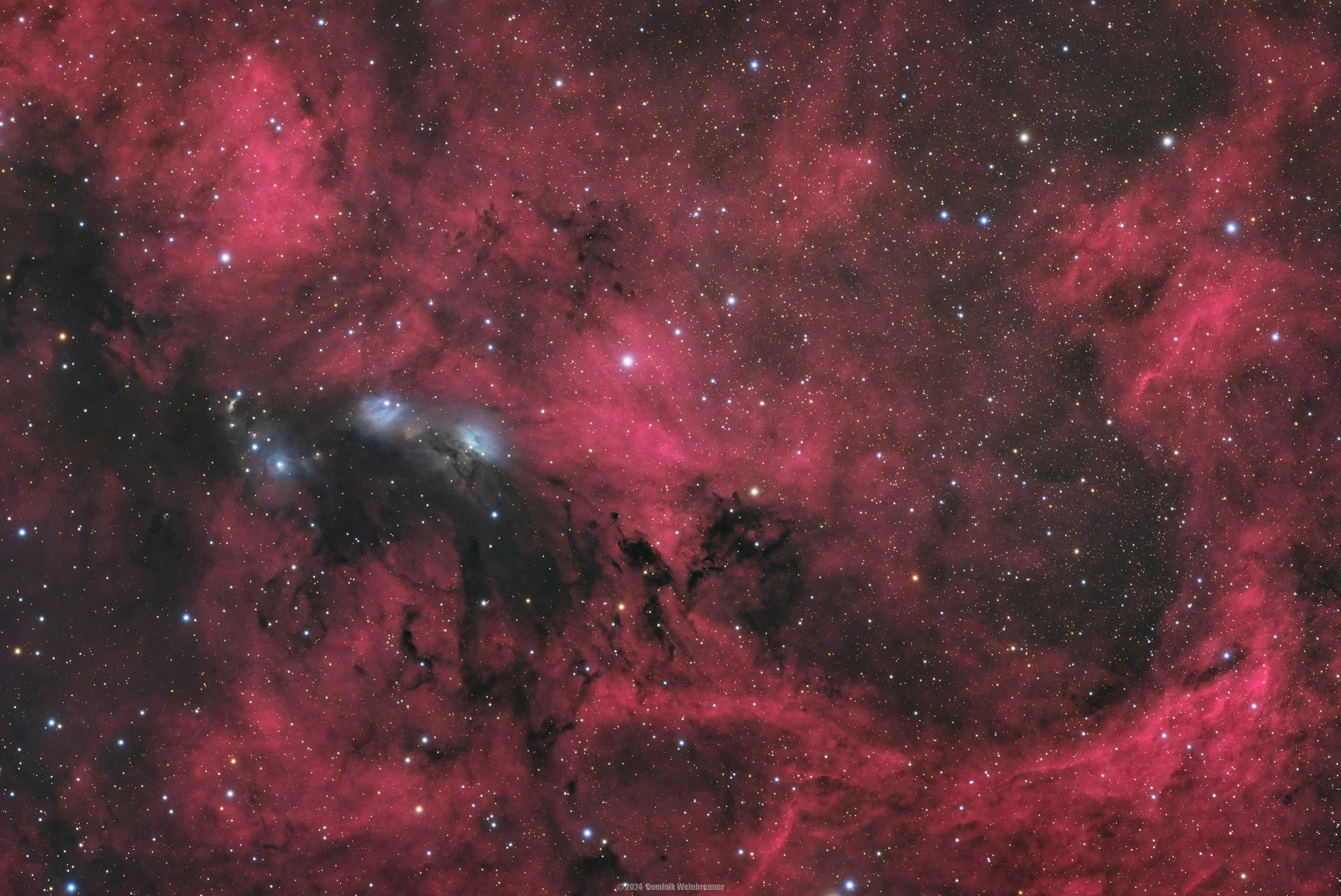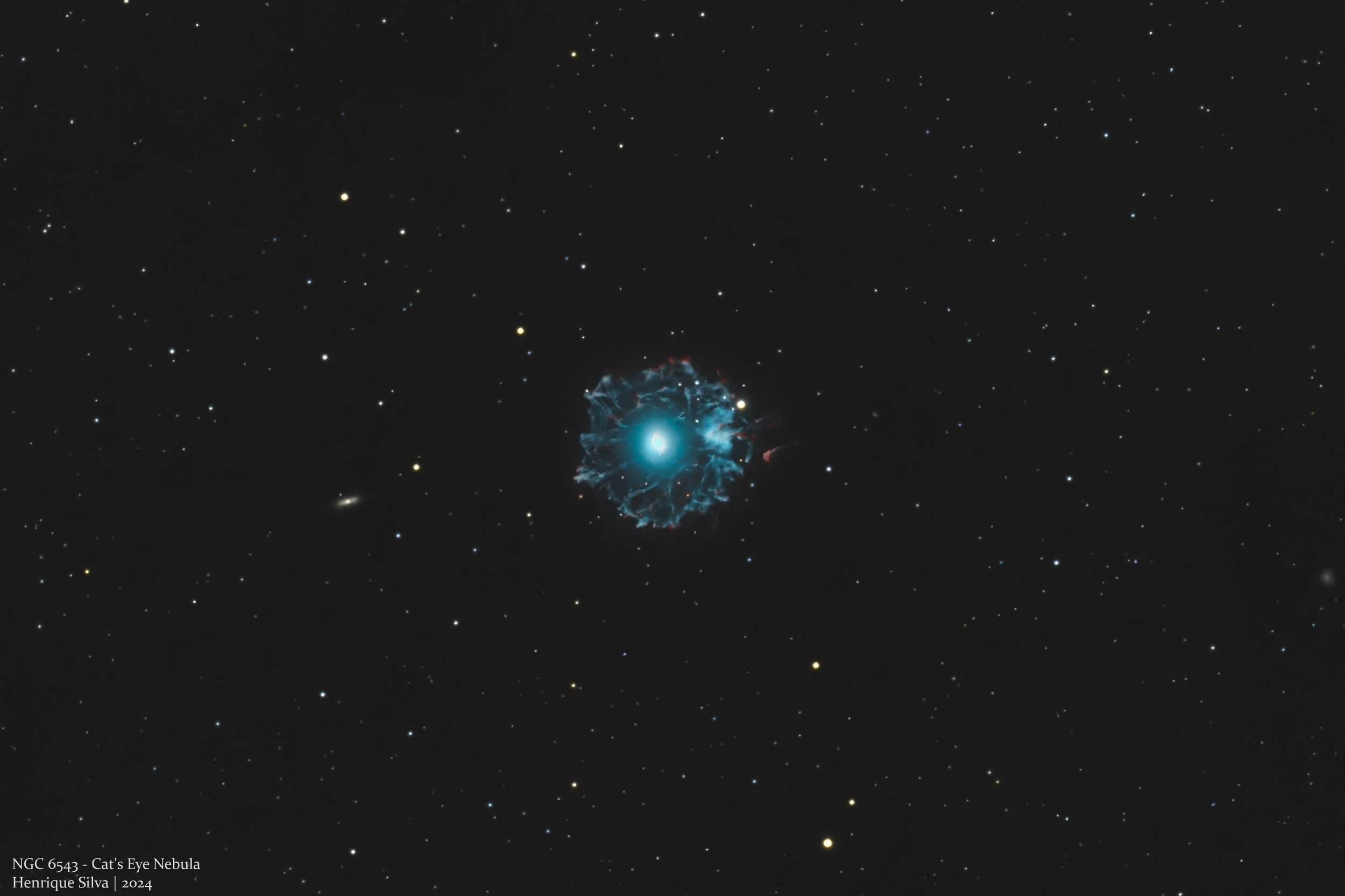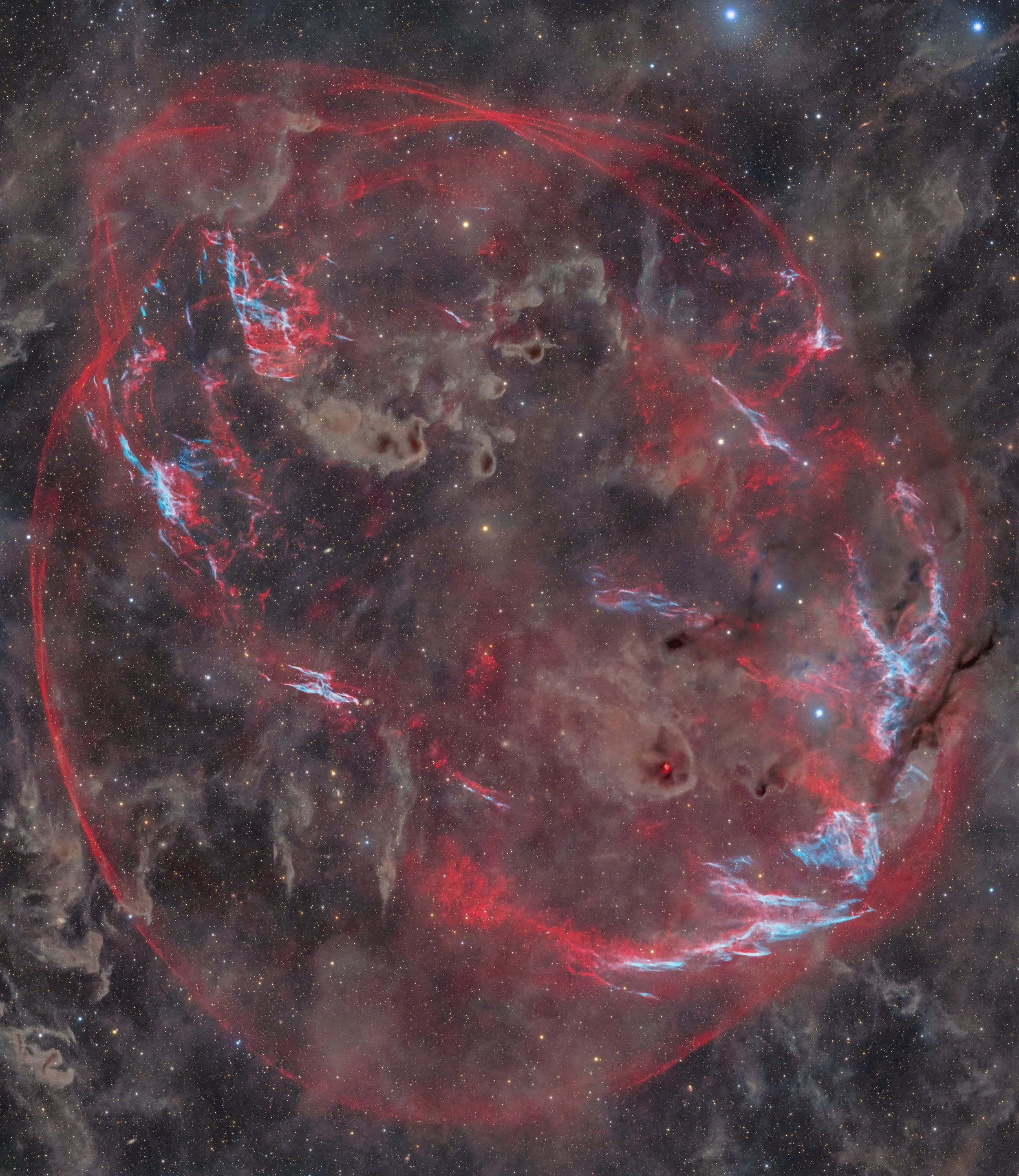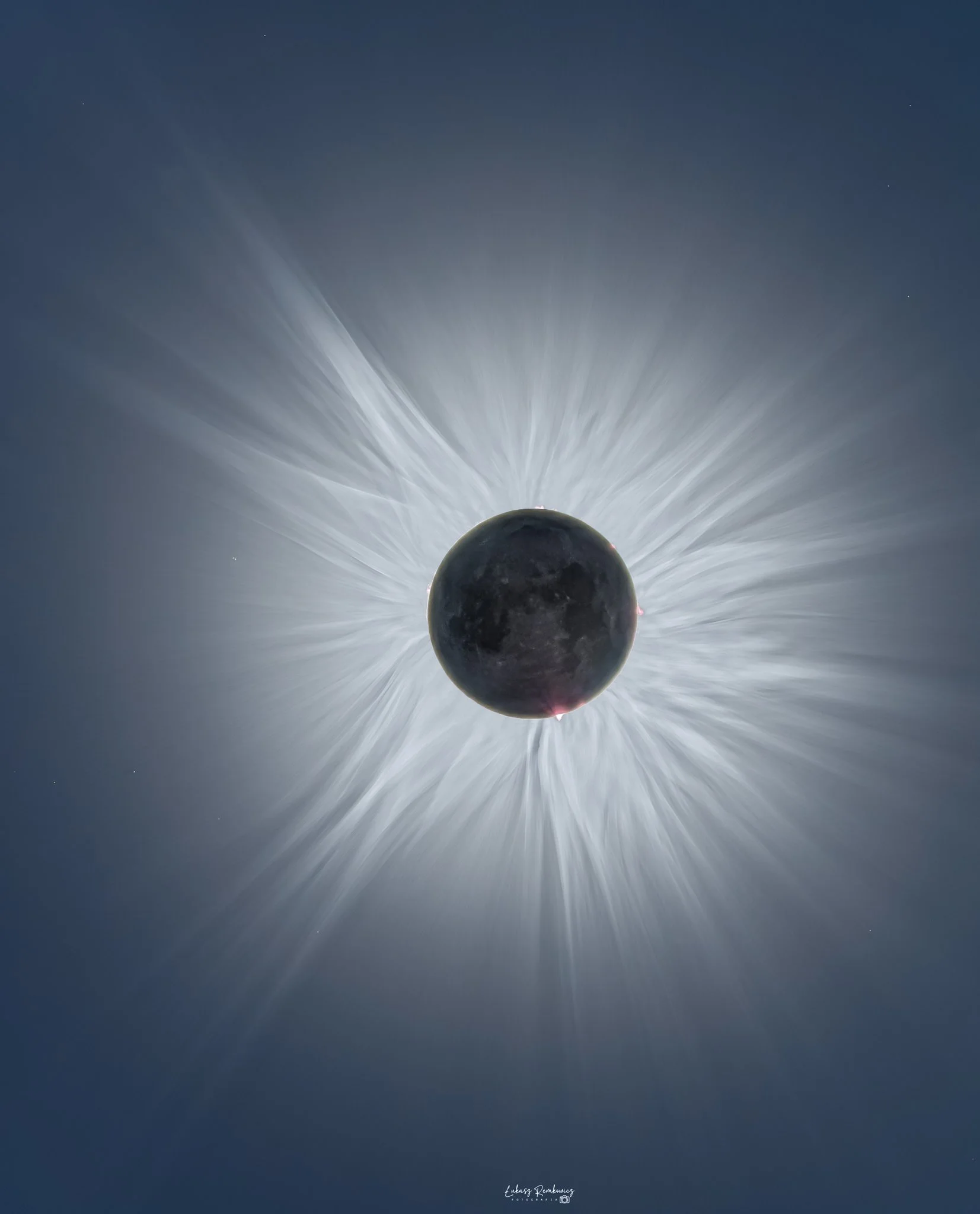
AAPOD2 Image Archives
LDN 673 in the Aquila Rift
Lynds Dark Nebula (LDN) 673 is a prominent dark nebula situated within the Aquila Rift, a region rich with interstellar dust and gas clouds. Spanning approximately 7 light-years across and located about 600 light-years from Earth, LDN 673 is a complex structure that obscures the light from background stars, creating an intricate tapestry of dark and light patches in the night sky. This dense molecular cloud is a site of active star formation, with numerous young stellar objects hidden within its veils of dust.
The Aquila Rift itself is a significant feature of the Milky Way, appearing as a dark band that bisects the bright star fields of the constellation Aquila. The rift's dark clouds, including LDN 673, are part of a larger network of star-forming regions that contribute to our understanding of the processes involved in stellar evolution. Observations of LDN 673 and its surroundings provide valuable insights into the initial conditions of star formation and the dynamics of interstellar matter.
Reflections in Cygnus
The constellation Cygnus, hosts a wealth of nebulous regions that captivate astronomers and astrophotographers alike. This image showcases several prominent nebulae, captured using LRGB (Luminance, Red, Green, Blue) and Hydrogen-alpha (Ha) filtered data to highlight their intricate details and vibrant colors. Among the notable objects in this region are the North America Nebula (NGC 7000), the Pelican Nebula (IC 5070), and the Veil Nebula Complex, remnants of a supernova explosion that occurred thousands of years ago.
The use of Ha filters is particularly effective in enhancing the visibility of hydrogen-rich regions, often seen as bright red emissions. These filters help isolate the light emitted by ionized hydrogen, providing a clearer view of the nebulae's structure and composition. Combining LRGB and Ha data allows for a more comprehensive and aesthetically pleasing representation of these celestial objects, revealing the dynamic processes of star formation and the interplay of cosmic dust and gas.
Bernard 72 Snake Nebula
Barnard 72, commonly known as the Snake Nebula, is a dark nebula located in the constellation Ophiuchus. This intriguing formation of interstellar dust and gas is approximately 650 light-years away from Earth and stretches over several light-years across the sky. Its sinuous, snake-like shape is caused by dense regions of dust obscuring the light from the stars behind it, creating a striking silhouette against the Milky Way's backdrop.
The Snake Nebula is part of a larger complex of dark nebulae cataloged by astronomer E.E. Barnard in the early 20th century. These dark clouds are sites of future star formation, as the dense material within them can collapse under gravity to form new stars and planetary systems. Observing Barnard 72 and other dark nebulae helps astronomers study the processes involved in star birth and the evolution of galaxies.
Comet C-12P Pons-Brooks March 18, 2024 20:23pm-21:24pm
Captured on March 18, 2024, from Alpe Grande in the Province of Como, Lombardy-Italy, Comet C/12P Pons-Brooks illuminates the night sky. Between 20:23 and 21:24, the comet’s luminous coma and tail provided a spectacular celestial display. This periodic comet, discovered by Jean-Louis Pons and William Robert Brooks, originates from the distant regions of the solar system, making its way through an elliptical orbit that brings it close to the Sun and Earth at regular intervals.
Comet Pons-Brooks, with its characteristic bright nucleus and expansive tail, offers a glimpse into the primordial material of the early solar system. Observing comets like Pons-Brooks helps astronomers understand the composition and behavior of these ancient celestial bodies, providing insights into the conditions that prevailed during the formation of the solar system. The image captured from Alpe Grande showcases the comet against the backdrop of the starry sky, a testament to the enduring allure of these cosmic wanderers.
Longmore-Tritton 5 (LoTr 5) Planetary Nebula
Longmore-Tritton 5, commonly known as LoTr 5, is a fascinating planetary nebula located in the constellation Coma Berenices. LoTr 5 is an expansive nebula, extending over 15 light-years across, making it one of the largest planetary nebulae known. The nebula's central star, an aging red giant, has shed its outer layers, creating a complex structure of glowing gas. The core remnant of the star, now a hot white dwarf, illuminates the ejected material, producing the characteristic luminescence observed in planetary nebulae.
LoTr 5 is particularly notable for its unusual morphology and large size, which suggest it has undergone significant interactions with the interstellar medium. This interaction creates an intricate pattern of knots and filaments within the nebula, visible in detailed astrophotographic images. The study of such planetary nebulae provides valuable insights into the late stages of stellar evolution and the processes by which stars enrich the interstellar medium with heavy elements, contributing to the cycle of star formation in the galaxy.
NGC 6559 (Chinese Dragon or Loreta Nebula) and NGC 6544
NGC 6559, also known as the Chinese Dragon or Loreta Nebula, is a complex star-forming region located in the constellation Sagittarius, about 5,000 light-years from Earth. This vibrant nebula showcases a stunning interplay of dark dust lanes, bright emission regions, and reflective patches, creating a vivid cosmic tapestry. The nebula's reddish hues arise from ionized hydrogen gas, while the blue regions are due to starlight reflecting off dust particles. NGC 6559 is an active site of stellar birth, where young, massive stars illuminate the surrounding gas and dust, sculpting the nebula into intricate shapes.
Nearby, NGC 6544 is a globular cluster, also in Sagittarius, situated approximately 8,500 light-years away. This dense collection of ancient stars provides a stark contrast to the younger, more chaotic environment of NGC 6559. Globular clusters like NGC 6544 are among the oldest objects in the galaxy, offering insights into the early history of the Milky Way. Together, the juxtaposition of the star-forming NGC 6559 and the ancient globular cluster NGC 6544 provides a compelling snapshot of different stages of stellar evolution and galactic development.
M83 - The Southern Pinwheel Galaxy with outer halo and star stream
M83, also known as the Southern Pinwheel Galaxy, is a barred spiral galaxy located about 15 million light-years away in the constellation Hydra. Renowned for its beautiful spiral arms and bright core, M83 is one of the most active and well-studied galaxies in the nearby universe. Its prominent spiral structure is marked by vibrant regions of star formation and intricate dust lanes, making it a favorite target for both amateur and professional astronomers.
Recent deep-sky observations have revealed an extensive outer halo and star stream surrounding M83, indicative of past interactions and mergers with smaller galaxies. These faint structures are remnants of tidal interactions, providing clues about the galaxy's evolutionary history. The halo contains globular clusters and older stars, while the star streams trace the paths of disrupted satellite galaxies. Studying these features helps astronomers understand the processes of galactic growth and evolution in the cosmos.
Active Solar Region AR 3712
ctive Solar Region AR 3712 is a highly dynamic and magnetically intense area on the Sun's surface. Solar active regions are characterized by strong magnetic fields and are often the sites of sunspots, solar flares, and coronal mass ejections (CMEs). AR 3712, in particular, has displayed significant solar activity, with frequent solar flares and complex magnetic configurations that intrigue solar physicists. These regions are critical to understanding the Sun's behavior and its influence on space weather, which can impact satellite operations, communication systems, and even power grids on Earth.
Detailed observations of AR 3712 using both ground-based telescopes and space-based instruments, such as those on the Solar Dynamics Observatory (SDO), have provided valuable data on the Sun's magnetic field dynamics and plasma interactions. The region's sunspots are areas where the magnetic field lines emerge from and return into the solar surface, leading to a suppression of convective heat transfer and thus cooler, darker spots. The intense magnetic activity in AR 3712 can result in solar flares, which are sudden bursts of energy that release massive amounts of radiation across the electromagnetic spectrum, contributing to our understanding of stellar magnetic activity and space weather phenomena.
Omega Nebula: M17 (SHO)
The Omega Nebula, also known as M17 or the Swan Nebula, is a massive star-forming region located approximately 5,000 to 6,000 light-years away in the constellation Sagittarius. This bright emission nebula spans about 15 light-years and is one of the youngest and most active stellar nurseries in our galaxy. The nebula's characteristic swan-like shape is formed by the intense ultraviolet radiation from newly born, hot stars, which ionizes the surrounding hydrogen gas and causes it to glow brightly.
In addition to its striking appearance, the Omega Nebula is an important object of study for astronomers. Its dense clouds of gas and dust harbor the processes of star formation, providing insights into the early stages of stellar evolution. The region is also home to a rich cluster of young stars, including several massive O-type stars that are primarily responsible for the nebula's illumination. Observations in various wavelengths, from infrared to radio, have revealed intricate details of the nebula's structure, shedding light on the dynamic processes at play in this stellar nursery.
X marks the spot ( NGC5907)
NGC 5907, also known as the Splinter Galaxy or the Knife Edge Galaxy, is a spiral galaxy located approximately 50 million light-years away in the constellation Draco. Its striking edge-on orientation reveals a thin, elongated profile, which makes it a prime example of a warped disk galaxy. NGC 5907's disk shows minimal bulging at the center, which adds to its thin, knife-like appearance.
An intriguing feature of NGC 5907 is the faint, extended tidal stream that forms an "X" shape around the galaxy. This stellar stream is a remnant of a past interaction or merger with a smaller galaxy, providing crucial insights into the galaxy's evolutionary history. Observations of NGC 5907 also reveal a low surface brightness dwarf galaxy companion, which might be contributing to its tidal features. The "X marks the spot" structure around NGC 5907 offers a fascinating glimpse into the complex gravitational interactions and mergers that shape galaxies over time.
M106
Messier 106 (M106), also known as NGC 4258, is a Seyfert spiral galaxy located about 24 million light-years away in the constellation Canes Venatici. This galaxy is notable for its bright nucleus and active galactic core, which houses a supermassive black hole. M106 exhibits prominent spiral arms that are rich in star-forming regions and interspersed with dark dust lanes. Its bright core and extended emission make it a popular target for both amateur and professional astronomers.
One of the most intriguing features of M106 is its anomalous spiral arms, which are visible in radio and X-ray wavelengths but not in optical light. These arms are thought to be jets of high-energy particles ejected from the galaxy's central black hole, interacting with the surrounding interstellar medium. M106 also has a notable water vapor megamaser, which has been used to make precise measurements of the galaxy's distance. This unique combination of features makes M106 an excellent subject for studying the dynamics of active galactic nuclei and the processes governing star formation.
M20 - Trifid Nebula in SHO and RGB Blend
Messier 20 (M20) - The Trifid Nebula
Messier 20, also known as the Trifid Nebula, is a striking combination of an emission nebula, a reflection nebula, and a dark nebula located in the constellation Sagittarius. This beautiful celestial object gets its name "Trifid," meaning "divided into three lobes," due to the prominent dark lanes that split the nebula into three distinct parts. At an estimated distance of 5,200 light-years from Earth, the Trifid Nebula is a significant site of star formation, where new stars are being born out of the interstellar dust and gas.
The Trifid Nebula showcases a vivid interplay of colors with its reddish-pink regions of ionized hydrogen (H II regions) glowing from the emission nebula, and the blue regions being the reflection nebula where starlight is scattered by the surrounding dust. The dark lanes are formed by dense clouds of gas and dust that block the light from the brighter regions behind them. Capturing images of M20, especially in multiple wavelengths, reveals intricate details about the processes of star birth and the complex structure of the nebula.
NGC6894 planetary
NGC 6894 is a Planetary Nebula located in the constellation of Cygnus in the northern hemisphere. NGC 6894 is called NGC 6894 in the New General Catalogue (NGC). This catalogue is a list of deep space objects compiled by John Louis Emil Dreyer in 1888 to update John Herschel's earlier work. NGC 6894 is not a Messier Object and doesn't have a Messier Number.
THE LEO TRIPLET - M65, M66 & NGC 3628
The Leo Triplet, also known as the M66 Group, is a stunning trio of interacting galaxies located about 35 million light-years away in the constellation Leo. This group consists of the spiral galaxies M65, M66, and NGC 3628, each showcasing unique structural features due to their gravitational interactions. M65 and M66 are both bright and prominent, with well-defined spiral arms, while NGC 3628, also known as the Hamburger Galaxy, displays a striking dust lane cutting across its edge-on orientation.
These interactions have led to the formation of tidal tails and distortions in the galaxies' shapes, providing astronomers with valuable insights into galactic evolution and dynamics. The Leo Triplet is a popular target for amateur astronomers and astrophotographers due to its relatively close proximity and the fascinating interplay of its member galaxies, making it a prime example of the cosmic ballet occurring throughout the universe.
600 Years of Trailing
Star trails over Tash-Rabat, a stone caravanserai built in the 15th century, create a mesmerizing display that reflects the Earth's rotation. Located in the Kyrgyzstan mountains, Tash-Rabat's remote and dark skies provide an ideal setting for capturing the celestial dance. In a long-exposure photograph, the stars appear to trace circular paths around the North Star, Polaris, which remains relatively stationary in the sky due to its alignment with Earth's rotational axis.
The reason the stars trail in circular patterns is because of the Earth's rotation. As our planet spins on its axis, the stars appear to move across the sky from east to west. In the Northern Hemisphere, when looking northward, the stars seem to rotate counterclockwise around Polaris. The closer the stars are to Polaris, the smaller the circles they trace; stars further away from Polaris create larger arcs. This effect is beautifully captured in long-exposure images, showing concentric circles centered on the North Star, which serves as the anchor point in the starry sky over the historic Tash-Rabat.
NGC 4395
NGC 4395 is an intriguing spiral galaxy located in the constellation Canes Venatici, approximately 14 million light-years away. Despite its relatively close proximity, NGC 4395 is one of the faintest galaxies in the Messier catalog, making it a challenging target for astronomers. This galaxy is classified as a low-luminosity Seyfert galaxy, hosting an active galactic nucleus (AGN) that emits significant radiation, likely due to a supermassive black hole at its center.
Imaging NGC 4395 from a Bortle 7 suburban location in Cork, Ireland, demonstrates the capabilities of modern astrophotography equipment and techniques. Despite the light pollution, the intricate details of this galaxy's structure, including its loose spiral arms and central region, can be captured. NGC 4395's active nucleus and its faint, extended arms provide a fascinating subject for both professional and amateur astronomers, offering insights into the complexities of galactic formation and evolution.
Messier 63 - Sunflower galaxy
Messier 63 (M63), also known as the Sunflower Galaxy, is a striking spiral galaxy located approximately 27 million light-years away in the constellation Canes Venatici. It was discovered by the French astronomer Pierre Méchain in 1779 and later included in Charles Messier's catalog of deep-sky objects. M63 is part of the M51 Group, a collection of galaxies that includes the famous Whirlpool Galaxy (M51).
M63 is notable for its flocculent spiral structure, characterized by many short, patchy spiral arms rather than the grand design seen in other spirals like M51. These arms are dotted with star-forming regions and clusters of young, blue stars, giving the galaxy its sunflower-like appearance. Recent studies have also revealed faint outer arms, suggesting M63 has undergone interactions with neighboring galaxies, influencing its structure and star formation activities.
NGC 6543 - Cat's Eye Nebula
NGC 6543, commonly known as the Cat's Eye Nebula, is a striking planetary nebula located in the constellation Draco, approximately 3,300 light-years from Earth. This nebula is one of the most complex planetary nebulae known, featuring intricate structures including concentric shells, jets, and knots of high-density gas. The central star, a dying red giant, has shed its outer layers, creating the glowing shell of ionized gas visible in detailed telescopic images.
The Cat's Eye Nebula is particularly noted for its rich array of colors, which are caused by different types of ionized gases. For example, the blue-green hues are from oxygen, while the reddish tones come from hydrogen and nitrogen. This nebula serves as a key object of study for understanding the end-of-life stages of medium-sized stars and the complex processes involved in the creation of planetary nebulae.
DSC – SNR G156.2+5.7 - The aftermath of a Star's Death
Supernova Remnant G156.2+5.7 (SNR G156.2+5.7), also known as SNR156, is an intriguing and relatively faint supernova remnant located in the constellation Camelopardalis. This remnant, spanning roughly 90 light-years in diameter, is a testament to the explosive death of a massive star, which occurred thousands of years ago. Its delicate filamentary structures are composed primarily of ionized hydrogen and other gases, which emit light as they interact with the surrounding interstellar medium.
SNR G156.2+5.7 is particularly notable for its relatively low surface brightness, making it a challenging target for observation. Studies of SNR156 have provided valuable insights into the dynamics of supernova remnants, including the mechanisms of shockwave propagation and the subsequent heating and ionization of interstellar material. Its discovery and subsequent analysis highlight the importance of advanced imaging techniques in unveiling the hidden details of such faint astronomical objects.
Solar Total Eclipse (HDR)
This HDR composite image of the Solar Total Eclipse, photographed in Arkansas, USA, captures the celestial event in stunning detail. The image is a blend of nine different exposures, ranging from 1/200 to 1.3 seconds, meticulously combined to reveal the intricate details of the eclipse. Visible in the photograph are the moonshine, the Sun's corona, and several solar protuberances, showcasing the dynamic interplay between the Moon and the Sun during this rare alignment.
The blending of multiple exposures allows for a comprehensive view of the eclipse, balancing the brightness of the Sun's corona with the subtle glow of the moonshine. The Sun's corona, the outermost part of its atmosphere, appears as a halo of plasma, visible only during a total solar eclipse. The solar protuberances, or prominences, are large, bright features extending from the Sun's surface, composed of hot ionized gases. This detailed capture not only highlights the beauty of the eclipse but also provides a scientific glimpse into the complex phenomena occurring in our solar system.





















